
Is there music in the grove?
Is bamboo surrounded inside and out with music?
Can bamboo communicate?
If so, how?
Can one interact with living Bamboo?
One day, an elderly gentleman who owned a bamboo garden came to my bamboo plantation. He looked around and said quite bluntly, "What are you doing?" I was a bit shaken and asked, "What do you mean?" He said, "You have all this bamboo struggling to grow in the shade and a whole bunch of junk trees shading them. If you get rid of those trees, your bamboo will grow better and you will have more bamboo than you will ever need and you won't have to travel to harvest it anymore.
Then he said, "And if you walk your bamboo every day, it will speak to you."
Now that's my kind of guy, I thought. If the bamboo could tell me how to grow it better for flute material, with thinner walls and longer nodes, I would be really happy. So I began walking my bamboo and began to hear it talking.
Its voice seemed to be telling anyone who would listen about how it was doing. Sort of telling you if it was happy or sad or frustrated. Like your house-plant telling you if it is thirsty. If I were to put a tittle on its communication, I would call it The Survival Level.
I learned that the simple voice of a living bamboo might be something as simple as:

"I really could use some more sun. Too much shade here now. Help!"
This shaded plant does not have much growth. Some clumps in the shade were moved to sunny areas and flourished. Some left in the shade died or remained stunted.
The communication of this bamboo might be saying, "I'm much stronger now, so my protective shield with splintery black itchy hairs that keep animals and people away, can be shed now."

Some of my bamboo seemed to say, "When you got rid of that scale bug off of me in 2011, the water from the pressure cleaner worked just fine, but the one you borrowed in 2012 was way too much pressure and freaked me out, and that's why I got all sticky a few days later. I was trying to heal myself. So please don't do that again."

These guys are saying, "Please keep that scrub pad away."
As recent as Jan 2013, my bamboo shouted out loud and clear concerning the way we scrubbed off the scale. "You scrubbed me way too hard with that abrasive pad last week, please don't do that again. You really zapped me."
Another time, it was like the bamboo spoke into my mind saying, "Thanks for getting that scale off of me with that softer pad, and by the way, don't I look much more colorful now?" The bamboo that had been scrubbed clean of the scale was absolutely beautiful, revealing bright rich colors that had been hidden for a year. The place was alive with color and it was exhilarating to walk by it.
Seems like the bamboo was saying, "Don't I look happy?"
And I was saying, "Boy, you look happy."
Bamboo: "Don't I look like I am singing?"
Me: "Boy, you look like you are singing."
Now there was a thought. The bamboo is happy and looks like it is singing.
Singing?
Which brings us into the voice of Level 2.
Not the language of the Survival Level: 'Human needs to better care for bamboo because bamboo is not happy,' but something more intimate, as if two friends were speaking to each other in good times.
But what to call Level 2? The Singing Level? The Being a Happy Bamboo Level? The Pleasure Level?
On my side of Level 2, the Pleasure Level, I find much gratification feeling rejuvenated by the oxygen bamboo gives, the cool shade it provides, its relaxing beauty, the soothing humming purr of the leaves in the breeze, the soft rug of bamboo leaves, the mysterious sounds when the wind makes it creaks.
And when there is a strong gust of wind, I love to watch a clump bow their heads together and straighten up together. It excites my heart and soul when I walk in my bamboo garden. I enjoy the birds singing in the bamboo and the butterflies moving about them. You might say, Level 2 is a delightful list of emotions under the title, "Human enjoys bamboo."
Here is a 1901 mention by Johanus Reimers recommending bamboo to be planted in California rail stations.
"Let us use the charming bamboos, with their rustle and glistening cleanliness in the eternal sunshine, the whispering music that every passing breeze plays on the Jews-Harps of their myriad of leaves and slender twigs."

Here is also a mention by Henry Nehrling a Florida pioneer horticulturalist and bamboo grower in 1897.
Speaking of a mockingbird singing in bamboo, here is a sample of me playing my Egyptian Bamboo Flute with a mocking bird that sat on the big yellow bamboo in my garden.
So, what is Level 2, the Pleasure Level, from the bamboo's point of view?
Does it enjoy people enjoying them? I don't know.
Can they detect me coming down the path admiring them, feeling my footsteps through the fine feeder roots? I don't know. But as it clearly can display its displeasure, it also displays its pleasure.
A happy Bamboo might say: "I am happy in the sun, I have created enough shade to keep the soil moist and me cool and my roots have now connected with some water below and look how gorgeous I am now? I am happy, strong and with that fertilizer you gave me back in the rainy season, I look beautiful."
But let's look deeper.

One of the outstanding features of this bamboo is its colorful green lines on a rich yellow background. Creating a Level 2 Pleasure experience to the viewer.
Recently, while walking in my bamboo garden, I thought about the beautiful green lines and wondered if there was another level of bamboo expression that I could not yet see?
A Level 2: Pleasure from the bamboo's point of view?
This "outside the box" thought hit me, "Are these unique patterns on each node, more than just genetic code? How about a code? A beautiful expression that we do not understand but in some way the bamboo has expressed itself in a beautiful way?" When I did not fertilize or water much and had too much shade this bamboo clump remained small and uninteresting. But when I took the tall trees out, fertilized and put in a water system it grew tall and beautiful with gorgeous green random patterns. So I know it is happier now.
Is it artistically expressing delight after having been fertilized? Growing wider, taller with beautiful marks.
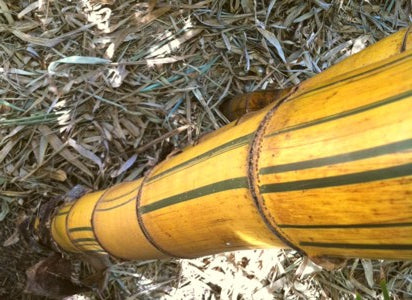
I began to look at the patterns of the green linear artwork and wondered: Could these lines be bamboo writing, on a bamboo notebook, written by bamboo, that could be read by a bamboo enthusiast, if he knew how to read the bamboo writing?
I imagine there is a scientific answer to the patterns. "Yup, that year you had more manganese in your fertilizer and it produced more artistic lines and patterns," or something like that.
But could it be an expression of the plant? A creative, artistic expression. Like a beautiful flower moving the viewer. Showing off the beauty of its being?
Oh, Oh, here's where some of my customers might want to call Belleview Hospital, "Hello Doctor, it's my Flutemaker; he's just stepped over the line." How about, just stepped 'out of the box'?
One of the first things God did on the earth was create a garden. And in the cool of the Garden, God walked and had fellowship with Adam and Eve. And God's kids were enjoying the garden, and talking with God and talking with the animals. (Remember when the serpent spoke to Eve, she didn't freak out that an animal was speaking to her, she just entered into a conversation).

I began to ponder, is there more to bamboo than meets the eye?
I gently wrapped my hand around one of those beautiful decorated nodes almost to say, "Hi, and thank you for being so beautiful," when all of a sudden I became intrigued by what I felt.
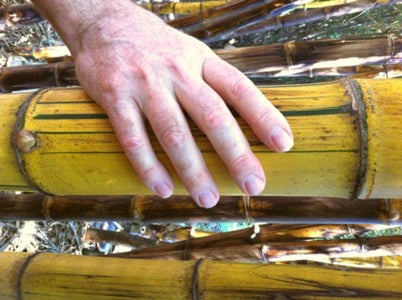
I have been harvesting bamboo for 42 years and I have never felt this before. Inside the culm was movement, vibrations and sound. It was amazingly strong and reminded me when I used to place my hand on my wife's abdomen to feel one of my babies moving inside.
While the wind blew, the bamboo touched, clicked and bumped each other above me. There were all kinds of tapping and physical noises going on inside of it. "Wow!" I thought, "There is music inside the bamboo!"
Then I pressed my ear against the bamboo and waited for the breeze. Wow! All kinds of sounds! Sometimes it sounded like the hull of an old wooden ship creaking its timbers out at sea. Another moment I heard what sounded like drumming and a gong. Then I thought, "I wonder if this can be recorded with a microphone?"
I placed my cell phone onto the bamboo and here is what I heard!
In Take One: After the first culm, listen closely and you will hear me pull the phone away, step on some bamboo leaves, rub the bamboo and put the phone on a new culm to catch another culm singing in the wind.
Take 2...
Take 3...
Bamboo is such a musical plant that Flutes, Bamboo Saxes, Clarinets, Xylophones, Guitars and Wind Chimes are made from it.

It does not surprise me that music would be all around it and inside of it while it is alive.
Now, enjoy a duo with a singing bamboo in the wind along with my wind splitting across a dry bamboo plant with holes. (I enjoy the thought that we are made in the image of our Creator and thus that manifests in our creativity.)
So that was a cool Pleasure 2 experience by bamboo joining bamboo flutemaker. Now lets move on to the unique art work on the nodes. To me, the green lines are an expression of the bamboo's beauty; like a voice or a language. And if so, would it be possible to interpret this language? Could I interpret the artistic lines? Could I go deeper into Level 2, and further enjoy the Creator's creation? Does the living bamboo plant want to express itself? It knows how to communicate its displeasure and does that easily. Is this musical plant expressing itself in a way that we cannot hear?
Then I looked at those green lines as if they were a code of communication. That they might be interpreted in some way that would take me into its Level 2.
Could it be that this musical plant, surrounded by nature's music, be somehow expressing itself in a music that we cannot hear?
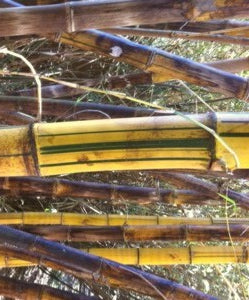
Could I interpret it? Could I read it?
And if I could read it, could I sing it?
And if I could sing it, could I play it on a flute?
So I began to look for bamboo music written on the bamboo node of the living plant. And before I knew it, I was reading it and I was singing it to those that came to tour my bamboo garden. There came a Christian Minister, A Buddhist Monk and a Scientist among others and when they placed their ear to the bamboo they we were all amazed. Then I began to play the music on the flute. Finally I began to record this music and to record myself improvising along with the bamboo music that I was reading.
I was now knocking on the door of Bamboo's Level 2.

For the sake of starting somewhere, I took the pentatonic scale of a D Oriental flute which has the following notes from low to high:
D F G A C D.

I saw the above lines as notes and the artistic pattern as a musical phrase. The first note on the left was not as wide as the last note, which was fatter, bigger or shall I say deeper like the widest string of a guitar. If the widest note was to represent the deepest note in the musical phrase, then the first note being sung or heard or played would be higher. Let's say the next note in that scale is F, not as wide as the low note D.
But there is a small line next to it. And what could that mean? F with something added to it? A flutter perhaps like a note of a singing bird on a bamboo branch.
Here is an interpretation:

F + Flutter


C (Thinner than F)

High C (very thin line interpreted as the same note an octave above)

D (the deepest note in this phrase)
So here is the sound of my interpretation of the green lines turned into music.
Keep in mind they say there are a thousand ways to wash dishes, so there will be many ways to interpret these lines musically.
This is what I started to do to read the bamboo music written by the bamboo.

After I play this "phrase" of the above bamboo music two times, I then join in improvising with my flute.
Hear it now...
Welcome to Level 2.

On the next piece, (from left to right) I first play 2 high notes, a low note and a medium note. Then I play the music from the right to the left, playing the medium note, deep note and the 2 high notes. Then I come in and improvise on top of that.
I am calling the following piece, "Music in the Grove", you will hear the bamboo lines from left to right then right to left.
You will hear my wind chime, me, a visiting flock of birds and the neighbor's rooster. A nice rendition of Level 2.
After I play this "phrase" of the above bamboo music two times, I then join in improvising with my flute.
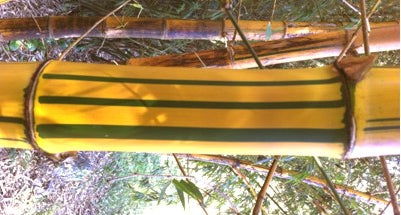
Below Erik reads the music on the bamboo and plays with the music inside the bamboo.


Now, listern to Erik play the outside music of the culm from node to node from the bottom to the top along with the inside music and him improvising on top of it.

The Stars of the Show
This article featured Bambusa Vulgaris Vittata from southen China that spread all over the world because of its beauty.

The featured flute in this article is our "Oriental Flute" available here.
Hope you enjoyed my discoveries, I sure did.
Erik the flutemaker,
Conclusion:
Is there music in the grove? YES
Is bamboo surrounded inside and out with music? YES
Can bamboo communicate? YES
Can one interact with living Bamboo? YES
Should you call the doctor because I have lost it? NO
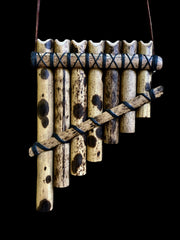
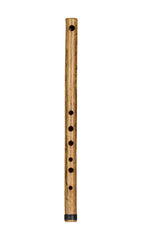
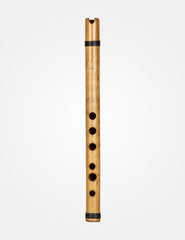
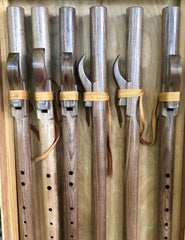
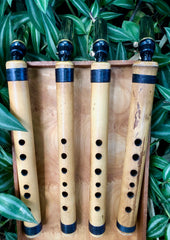
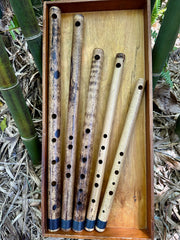

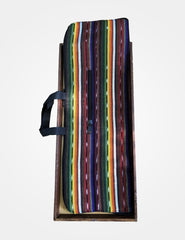






Absolutely mesmerizing.. beautiful bambooo, thank you .. <3
Pretty clever and fun. I am a geologist and have gone to Bible College. I used to say, "As geologist, I perceive the ages of the rock, but as theologist (coined I believe) I perceive the Rock of the Ages.
Beautiful, truly Beautiful
I love this story and the personification it gives to the bamboo. It makes me think, humans were made to listen because so many things like animals or bamboo, for example, have something to teach us. We just need to listen.
I really enjoyed this!! I love the sounds of nature music that is in dialogue with them. It’s great to know the Bamboo groves are happy and looked after lovingly.
David